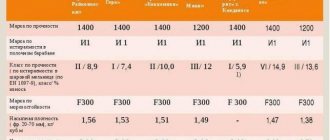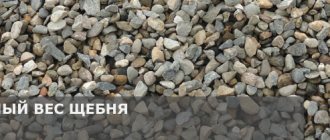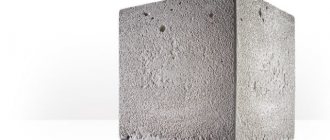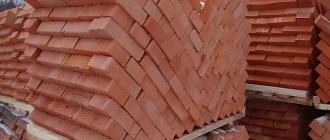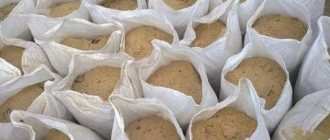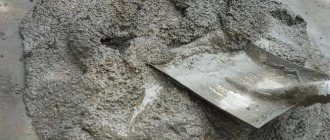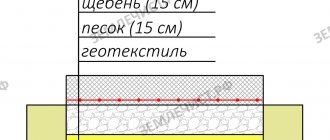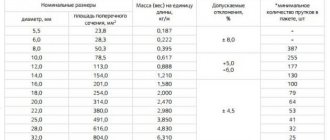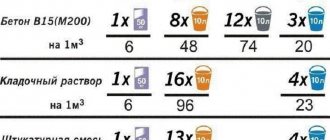Softwood boards are often used for construction and repair. Lumber is usually measured in cubic meters or, in common parlance, in cubes.
Before starting construction or renovation, they always calculate the costs and draw up an estimate. At this stage, the question may arise about the weight of the necessary building materials in order to more accurately calculate the cost of delivery.
How many kg in m³?
Metric system
| kilogram per cubic meter to ton per cubic meter (t/ m³ ) | 0.001 |
| kilogram per cubic meter to gram per cubic meter (g/ m³ ) | 1,000 |
| kilogram per cubic meter to milligram per cubic meter (mg/ m³ ) | 1,000,000 |
| kilogram per cubic meter to kilogram per liter ( kg /L) | 0.001 |
| kilogram per cubic meter to gram per liter (g/L) | 1 |
What affects the weight of the board?
The main factor influencing the weight of lumber is its moisture content and density.
Dry wood has a lighter weight, the difference can be up to 40% compared to the weight of wood with natural moisture.
Depending on humidity, the following types of wood are distinguished:
- Fresh (freshly cut) – has indicators over 71%
- Wet – from 46 to 70%
- Raw – 25-45%
- Air-dry – 19-23%
- Dry – 10-18%
As a rule, density also depends on humidity, but it may be less if the wood has internal defects or is damaged by a pest. Then voids can form inside, ultimately affecting the weight.
How many cubic centimeters are in one kilogram?
Metric system
| kilogram per cubic centimeter to ton per cubic meter (t/m³) | 1,000 |
| kilogram per cubic centimeter to kilogram per cubic decimeter ( kg /dm³) | 1,000 |
| kilogram per cubic centimeter to gram per cubic decimeter (g/dm³) | 1,000,000 |
Weight of softwood lumber
The weights of the main types of boards used in construction are indicated in the table below. Weight is indicated in tons per 1 cubic meter for different humidity levels.
It is clear from the indicators that fresh (or damp) wood can weigh almost twice as much as well-dried wood with a moisture content of 10-15%.
For example, how much does a cube of pine weigh? According to the table, 1 cubic meter of fresh pine is 820 kg, with a humidity of 25% - 540 kg, and dry pine weighs 470-510 kg.
Let's also consider the weight of a cube of spruce, as the most commonly used materials: fresh wood weighs 760 kg per cubic meter, with a humidity of 25% the weight will be 470 kg, dry spruce will weigh 420-450 kg.
The lightest conifer in terms of weight is Siberian fir - fresh weighs 680 kg per cube; one of the heaviest conifers is larch - 940 kg per cube fresh.
How many square meters are in 1 cube?
You need to determine how many cubic meters one unit is equal to using the formula V= h*a*L (L – length, h – thickness, a – width, V – number of cubes). ...
| How many square meters in 1 cube | ||
| Length | Thickness, width | m2 / sq.m. |
| 6 meters, 6000 mm. | 50*250 | 19.995 |
Interesting materials:
What are standard raspberries? What is a shunt and what is it used for? What is a lift seat? What is edible mastic? What are removable oven runners? What are silicone earplugs? What is cutting speed in milling? What is drain without spin? What is C5 mixture? What is a salt marsh and how is it formed?
How much does 1 cube of cement weigh?
Question. Hello! Before buying cement for building a house, I want to learn how to handle the amount of cement in kilograms that fits into a container with a volume of 1 m3. How much does 1 cube of cement weigh? It is advisable to provide information on different types of binders. Thank you!
Answer. Good afternoon To fully understand the calculation of the amount of cement in kilograms that a 1 m3 container can hold, you should consider a variable characteristic - bulk or specific density, measured in kg/m3. Bulk density depends on the type of cement and the degree of its “freshness”. For example, the density of one of the most popular types, Portland cement, can have the following values:
- Freshly ground cement: 1100-1200 kg/m3.
- C cement lying (stored for a certain time): 1500-1600 kg/m3.
- Average payment value used for practical calculations: 1300 kg/m3.
Thus, theoretically, 1 m3 can fit from 1100 to 1600 kilograms of Portland cement. The exact figure should be determined in each specific case, for a specific batch. In the laboratories of concrete and cement plants, special equipment is used to determine the density of cement - the Le Chatelier device. At home, you can calculate the bulk density and determine how much 1 m3 of cement you purchased weighs as follows:
- Prepare any suitable 1-liter container and more or less accurate scales.
- Weigh the container and write down the numerical value of the mass in kg: M1.
- Pour cement into it. Do not compact or shake the container. Weigh again and write down the numerical value of the mass of the container with cement in kg: M2.
- Calculate the specific gravity using the following formula: (M2-M1)/0.001, where 0.001 is the volume of your vessel in m3. As follows from the above, the value of the resulting specific density is the answer to the question: How much does 1 cubic meter of cement weigh?
Due to the fact that different types of cements have different bulk densities, it makes sense to provide a comparative table of the specific densities of different types of binders:
| Type of cement | Specific density, kg/m3 |
| Portland cement | 1200-1300 |
| Slag Portland cement | 1100-1250 |
| Sulfate-slag | 1000-1200 |
| Pozzolanic Portland cement | 850-1150 |
| Sulfate resistant pozzolanic | 800-1100 |
| Aluminous | 950-1150 |
It is worth noting that the specific density of cement varies depending on its brand. For example, the theoretical density of the binder of the most popular brands: TsEM I 22.5N PTs, TsEM I 32.5N PTs and TsEM I 42.5N PTs (old markings M300, M400 and M500) is 1100 kg/3, and the density of cement M100, M150 and M200 is 900 kg/m3.
What does the weight of the earth depend on?
The fact is that this is influenced by many factors, among which the most important are the degree of moisture of the soil body (the amount of moisture that the soil volume contains at the time of measurement), as well as the mineralogical composition of the soil, on which its density depends.
The higher the degree of soil moisture, the greater its weight. As a rule, after rain or near bodies of water, the weight is maximum. During periods of drought, it is minimal, as is the weight of the earth in dry, upland areas. In addition, the more dense the substance of which the earth is composed, the greater the weight 1 cubic meter of such earth will have.
How much mortar for 1 m3 of screed
To solve this issue, as in Section 2, we will use a specific example. So, again the task: “How many cubes of sand concrete solution will be required to make 1 m3 of finished screed.” The question seems a little confusing, but the good news is that we already know how to do this and have done it before. So the algorithm (going backwards):
- Find out how much dry mixture is required for 1 m3 of screed (Section 2);
- Find out how much of this mixture can be used to make a solution (Section 1);
So, in order.
We found a solution to question No. 1 in the previous section, the answer was 1800 kg.
Now, you need to find out how much solution will be obtained from 1800 kg of mixture. We did this at the very beginning of the article (only here the task is the opposite). We calculated that 1 cubic meter of solution consists of 1770 parts of the mixture and water in the proportion of 1 kg + 0.13 l. or in other words, to make 1 m3 of solution we need 1770 kg of dry mixture. To solve, it is necessary to calculate the proportion, if from 1770 kg we get 1 m3, then from 1800 kg we get 1800 / 1770 = 1.02 m3 of solution. This is the answer.
Weight depending on soil composition
The smallest weight is 1 cubic meter of soil, taken from the area of high or low bogs and consisting of peat and organic humus - only 700-900 kilograms, or 0.7-0.9 tons. The weight of 1 cubic meter of steppe and forest-steppe soil - typical black soil - is 1.4-1.5 tons. Chernozem consists of fractions of both light and heavy mineralogical composition. This weight of land is optimal for carrying out various types of agricultural work.
A cubic meter of sandy loam weighs approximately 2.6 tons, loam - 2.61 tons, sand - 2.65 tons, clay - up to 2.8 tons. The fact is that the smaller and denser the particles, the greater the amount of earth by mass that can fit into 1 cubic meter.
Clay, unlike all other types of earth, consists of very small particles of very high density. Therefore, the weight of 1 cubic meter of clay is maximum. It should not be forgotten that the data given is only valid for completely dry soil and can be used to solve theoretical problems.
Weight of the earth depending on soil moisture
To understand how much a cube of earth weighs in reality, it is necessary to introduce the concept of moisture coefficient. The moisture coefficient is an average value that characterizes the absorption capacity of a particular type of soil. This value shows the maximum amount of moisture that a particular type of soil can absorb. It increases the weight of 1 cubic meter by a given number of times.
So, to find the weight of 1 cubic meter of wet sandy loam, you need to multiply the weight of dry sandy loam by 1.7. For sand the coefficient is approximately 2.7, for clay - 2.6, for loam - 2.4. This way you can find the weight of 1 cubic meter of soil under completely wet conditions.
Source
Weight of 1 m3 of different types of wood
The table shows data on the weight of a cubic meter (cube) of 170 different types of wood at a standard humidity of 12%.
| Wood type | Weight of a cubic meter (cube) of wood in kilograms |
| Abacha | 420 |
| Apricot | 780 |
| Awodire | 690-750 |
| Azobi | 960-1120 |
| Quince | 640 |
| Ailanthus | 680 |
| Acacia | 690-750 |
| Amazaku | 850 |
| Amaranth | 800-950 |
| Anegri | 510-570 |
| Anchar | 550 |
| Afromosia | 710 |
| Bagassa | 800 |
| Lignum vitae | 1300 |
| Balau | 880-950 |
| Balsa (balsa) | 130-225 |
| Bamboo | 510 |
| Velvet | 160 |
| Belian (bitis) | 1200-1300 |
| Birch | 640 |
| Karelian birch | 600-750 |
| Bibolo | 580 |
| Bilinga | 740-810 |
| Bokote | 650 |
| Hawthorn | 760 |
| Bubingo | 800-960 |
| Beech | 650 |
| Wenge | 850-1000 |
| Faith | 1100 |
| Heather | 840 |
| Cherry | 530 |
| Elm | 650 |
| Gabon | 450 |
| Garapa | 830 |
| Hevea | 650-800 |
| Goyabao | 650 |
| Gombeira | 1150 |
| Goncalo | 850-950 |
| Hornbeam | 800 |
| Grenadill | 1200-1500 |
| Pear | 700-750 |
| Guarea | 640 |
| Dabema | 560-710 |
| Daru | 850-960 |
| Denya (okan) | 960 |
| Jelutong | 450 |
| Doxia | 650-1050 |
| Oak | 700 |
| Red oak | 650 |
| Stained oak | 950-1100 |
| Cork oak | 140 |
| Douglasia | 480-540 |
| Dussia | 800-830 |
| Spruce | 450 |
| Zebrano | 690-740 |
| Zirikote | 900 |
| Willow | 450 |
| Ipe (lapacho) | 960-1200 |
| Iroko | 660 |
| Elm | 660 |
| Cassia | 900-1300 |
| Cowrie | 380-560 |
| Chestnut | 600-720 |
| Horse chestnut | 470-580 |
| Cedar | 580 |
| Keltis | 800 |
| Kempas | 880 |
| Keruing | 640-860 |
| Kingwood | 1200 |
| Cypress | 460-485 |
| Cladrastas | 450 |
| Maple | 530-650 |
| Sugar maple | 740 |
| Cocobolo | 990 |
| Coconut | 690 |
| Kosipo | 640 |
| Koto | 580-650 |
| Kulim | 750 |
| Kumara | 1100 |
| Kumier | 1010-1150 |
| Kurupai | 1000 |
| Lacewood | 550-580 |
| Lauren | 710 |
| Limba (ofram) | 560 |
| Linden | 380 |
| Larch | 650-800 |
| Loro preto | 680 |
| Magnolia | 500-560 |
| Madrona | 620-660 |
| Maysamsa | 950 |
| Macassar | 850-900 |
| Maclura | 850 |
| Makore | 640 |
| Mansonia | 610 |
| Maraullah | 700 |
| Marfim | 850-930 |
| Mahogany | 620-650 |
| Meranti | 500-700 |
| Merbau | 830 |
| Miroxylon | 850-1050 |
| Myrtle | 950 |
| Moabi | 800 |
| Movingu | 690 |
| Juniper | 920 |
| Morado | 870 |
| Muirapiranga | 800-1060 |
| Niove | 880 |
| Olive | 850-950 |
| Alder | 420-640 |
| Nut | 600-650 |
| Black walnut | 660 |
| Ormozia | 740 |
| Aspen | 480 |
| Holly | 640 |
| Paduc | 750 |
| Rosewood | 770-830 |
| Parrotia | 900-1050 |
| Pecan (hickory) | 900 |
| Peroba | 750 |
| Pinkado | 990 |
| Fir | 450 |
| Sycamore wedge-leaved | 620-660 |
| Gonistylus macrofolia | 670-710 |
| Red gum | 500 |
| Rosewood | 860-1030 |
| Rosul | 960 |
| Mountain ash | 600 |
| Boxwood evergreen | 830-1100 |
| Sunbau | 760 |
| Santal | 660-720 |
| Sapelli | 600-650 |
| Sassafras whitish | 480 |
| Sequoia evergreen | 290 |
| Sep | 560 |
| Sitka | 430 |
| Homemade plum | 750-850 |
| Snakewood (Piratinera guianensis) | 1300 |
| Pine | 460-620 |
| Cedar pine | 450 |
| Sapupira | 990 |
| Tali | 910 |
| Tamo | 720 |
| Tauari | 620 |
| Teak | 620-750 |
| Yew berry | 620 |
| Poplar black | 380 |
| Thuja | 510 |
| Tyama | 560 |
| Tulipea | 480 |
| Ulin | 860-980 |
| Umnini | 990-1050 |
| Fernambuc | 620 |
| Pistachio | 860 |
| Framir | 480-625 |
| Hemlock | 490 |
| Persimmon | 830 |
| Zeder | 480 |
| Che | 1200-1300 |
| Bird cherry | 720 |
| Cherries | 580 |
| Mulberry | 800 |
| Eben | 1200-1300 |
| Eucalyptus | 650 |
| This | 580 |
| Apple tree | 780 |
| Sycamore | 650 |
| Yacaranda | 830 |
| Yarra | 850-1100 |
| Tall ash | 700 |
| Jatoba | 840 |
